How to find out what options a Tesla has
Last updated 27-Oct-2024
Tesla don't have many options that owners can select today, but over the years there have been some significant changes to the hardware. This guide explains how to find out what options a Tesla has including FSD, MCU version and Raven. You can alo find out whether the car has a heat pump, air suspension and premium audio.
To understand the features that vary between each of the options we created a guide to the feature differences between hardware versions
The easiest way to determine the majority of options a Tesla has is to be sitting in the driver’s seat. From there you can follow the following steps to determine what the car has and by understanding the displays, what the car doesn't have by a features absence in the list. The steps are broadly the same irrespective of the model.
The software version running in the car can make a difference, although any car running 2022.xx or later software should be fine.
If you are talking to a seller about a car, ask them for a photograph of the following two screens. We believe any dealer that really understands Tesla cars will know why you are asking, will have no problem in being able to take these pictures and will be confident in the description they have given you matches the cars data. If they are unwilling or unable to take these pictures without a good explanation, we suggest avoiding the seller. A good seller who understands Tesla will have already included pictures in their advert.
Basic Spec
In multiple places including the app, the car and even on your web based Tesla account you will find a list of the car spec. This lists the basic configuration of the car including model, colour, wheels etc. This list is at the time of order, so any features that have been changed after delivery, for instance wheels, will not be recorded.
While this may list free supercharging, do not assume this will transfer if you are looking to buy the car. We explain more further down the page.
The warranty tab can also prove useful to establish dates. The warranty dates are 4 and 8 years after first registration which will be some time after the build date, so again, you can not assume that a car registered on a particular date will have some of the more hidden features, such as the heat pump, from this date. We help answer those additional questions below.
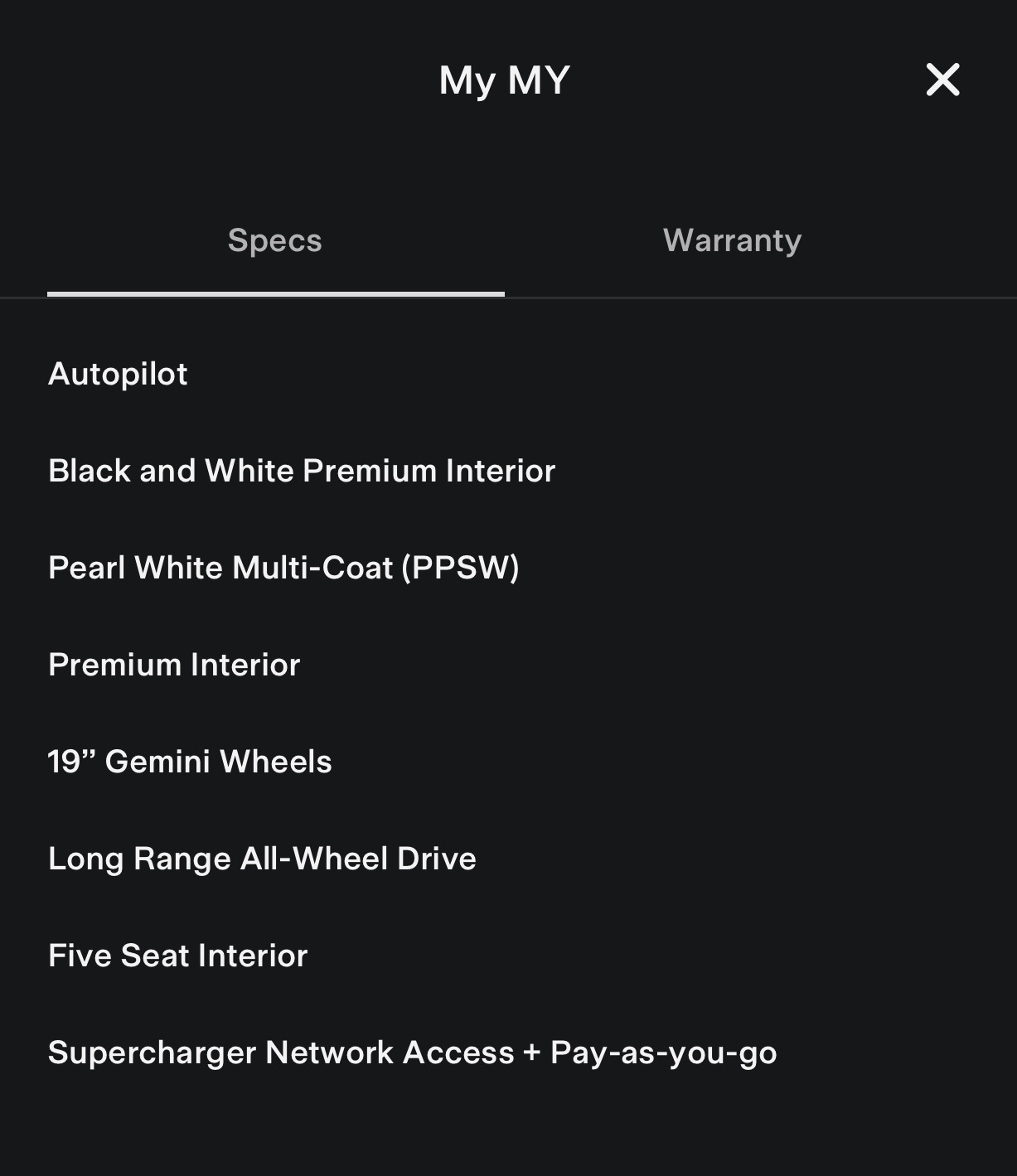
Software menu
The first thing to do is to click on the car icon in the bottom right-hand corner. This will bring up a menu on the screen. On the right-hand side there are a list of options, the last of which is called "Software". Click this menu item and the display will list included packages from the following list:
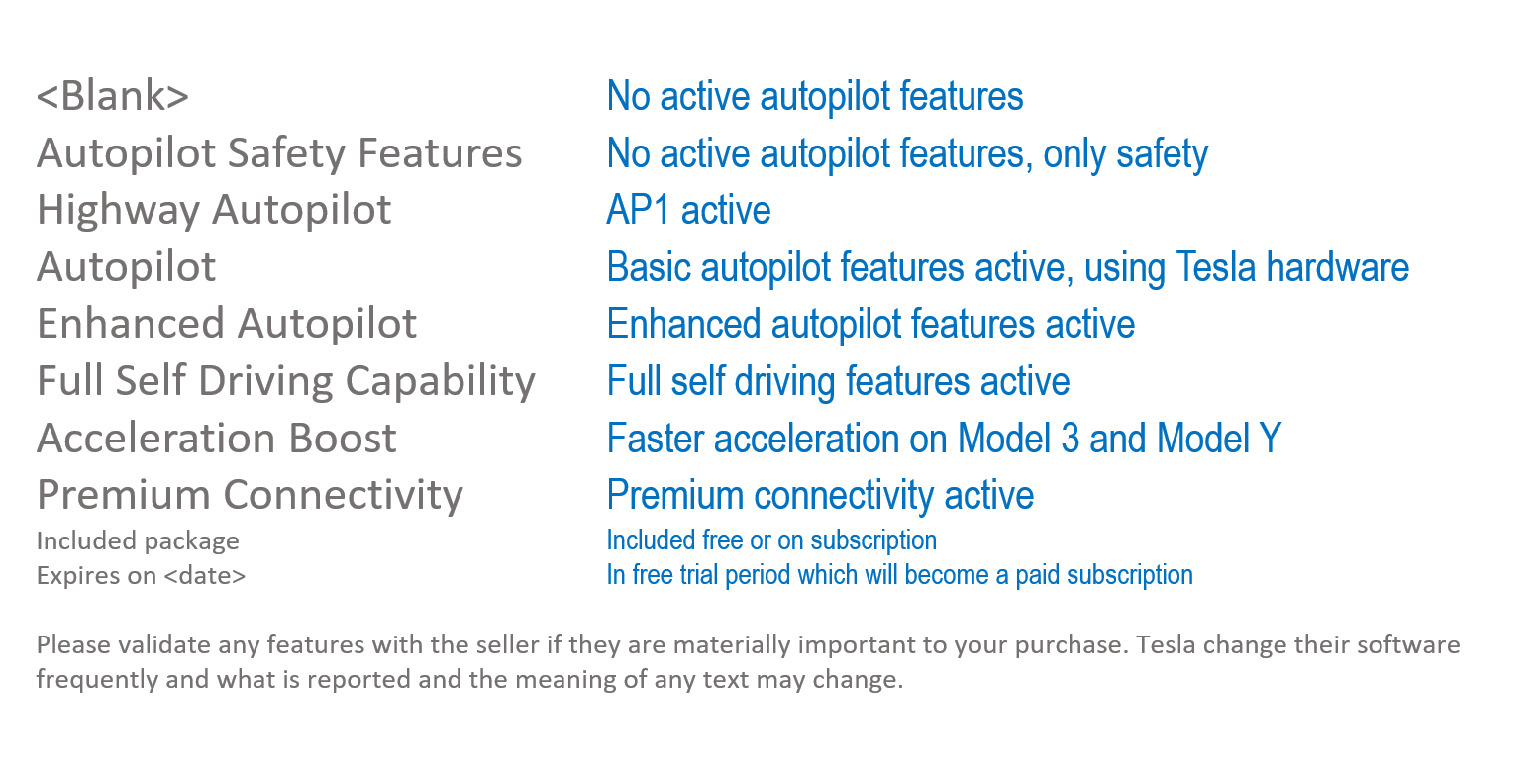
Software menu examples
-
Tesla with No activated Autopilot software

MS and MX cars with "Autopilot Safety features" are cars that have autopilot hardware but the car has not had any Autopilot software enabled. Tesla will generally still allow owners to purchase Autopilot as a cost option, the price of which depends on whether the car has AP1 hardware or the later Tesla hardware and whether the buyer selects basic Autopilot, Enhanced Autopilot (when they offer this), or Full self-driving where the car has suitable hardware.
The screen also implies that premium connectivity is included in the car and is not on a free trial period. It may however be on a paid subscription.
-
Tesla Model 3 with No activated Autopilot software
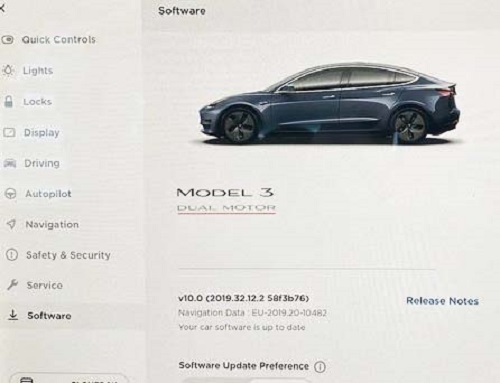
Model 3 cars without Autopilot software activated show nothing under software unlike the MS and MX. The car will have safety features enabled such as emergency braking despite not showing it.
-
Tesla with Autopilot 1 activated
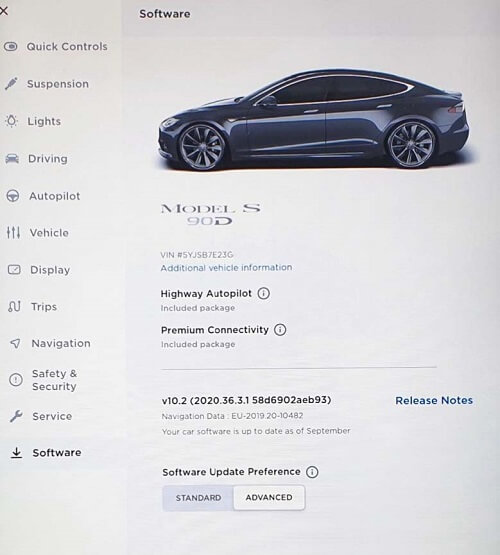
Where the car has Highway Autopilot, this is the generic term for Autopilot 1 (or AP1) which was the first iteration of autopilot using the Mobileye system. The features include traffic aware cruise control, lane keep, lane change, parking, basic summon and speed limit detection. It will not have any new features added but is relatively mature in the features it does have.
-
Tesla with Autopilot activated
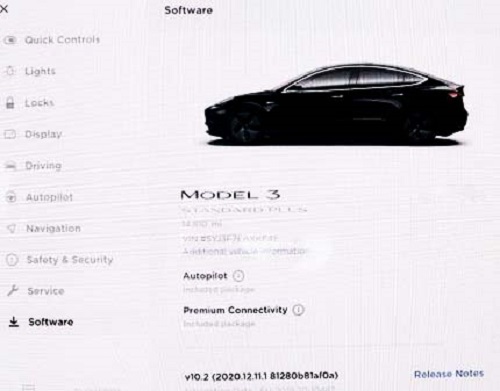
Where the car has just Autopilot listed, this is the basic autopilot features using the Tesla hardware. The features include traffic aware cruise control and lane keep. Other features such as lane change, navigate on autopilot, parking, and summon all require full self-driving to be ordered or Enhanced Autopilot when Tesla offer it.
-
Tesla with Enhanced Autopilot activated
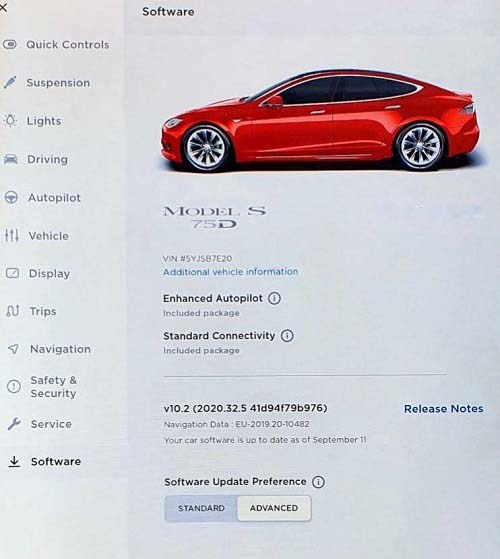
Enhanced Autopilot is the extended autopilot system using the Tesla hardware. The features include traffic aware cruise control, lane keep, navigate on autopilot, lane change, summon, parking etc. It does not have the enhanced features such as Traffic light stop and go and auto-steer on city streets which requires FSD. It is also unknown how much further Tesla will develop EAP as a suite of features.
-
Tesla with Full self-driving activated activated
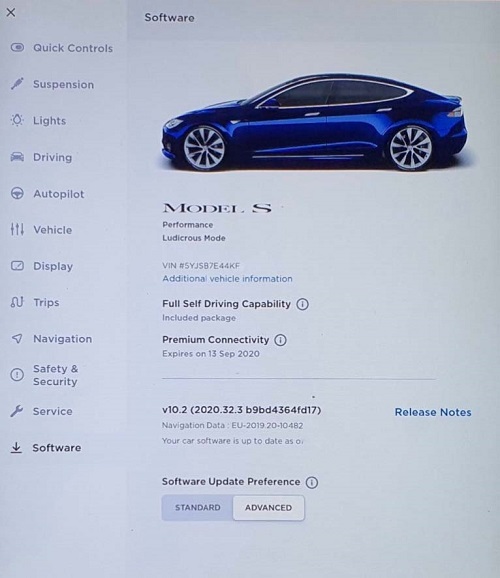
Full self-driving is the ultimate autopilot system using the Tesla hardware. The features include all the autopilot features that Tesla have developed including all those listed as part of EAP plus Traffic light stop and go and auto-steer on city streets which requires FSD.
The key difference however to EAP is that FSD will continue to expand as Tesla develop new features and Tesla will also undertake any necessary hardware upgrades necessary for those features to work, should they be required.
This particular screen shot also shows that premium connectivity is under a temporary offer and will revert to a subscription basis once the free period has ended.
-
Tesla M3 LR with Acceleration boost
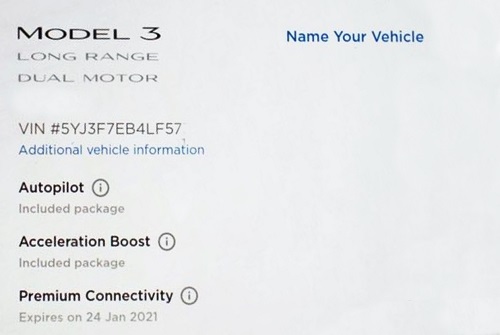
The Model 3 Long Range has an acceleration boost option which increases the power to make the performance closer to the Performance model but without the sports suspension, uprated brakes and larger wheels. There is also a stealth performance model (sometimes called a P3D-) which is different again which is signified by an underline of the Dual Motor but does not have red brake callipers. A stealth performance has more power than an acceleration boost long range, but the differences are fairly small in the real world.
This particular car only has the basic autopilot and premium subscription which will expire and become a paid for option.
Additional vehicle information
While the Software menu details the software options on the car, many owners and potential buyers also want to know more information about the actual hardware installed on the car as some features such as Sentry mode are dependent on the hardware installed. Pressing the "Additional vehicle information" option on the above screens will cause a pop up to be displayed with additional technical information.
Air suspension type
Missing = coil suspension, Standard = MS and MX pre Raven, Adaptive = MS and MX Raven, 2021 Facelift
Audio system
Base = non premium, Premium = Upgraded/Premium, Premium Speakers, no external amplifier = Premium without pedestrian warning
Autopilot computer
1.0 Computer = early pre late 2016, 2.0 Computer = HW2, 2.5 Computer = HW2.5, Full self-driving computer 3 = HW3, Full self-driving computer 4 = HW4 (note these are the hardware version only)
Brake Package
Base, or Performance
Cabin Heater
Heat pump for cars equipped with it, or Resistive for cars that don't.
CCS adapter support
Applicable to early MS and MX models in some countries such as Europe.
Cold weather package
Cold weather or subzero fitted and whether the steering wheel and windscreen beneath the wipers are heated.
Garage door opener
Homelink = garage opener installed
Infotainment processor
NVIDEA Tegra = MCU1, Intel Atom = MCU2 and M3,MY, AMD Ryzen = MCU3 and 2021 MS, MX
Low Voltage battery type
Lithium Ion, typically cars built from 2022, or Lead-acid for cars built before then
High Voltage battery type
Lithium Ion Phosphate plus others
Motor type front
AWD, On MSX Induction = not single foot driving, Permanent magnet = one foot driving
Motor type rear
Induction small = none performance MSX, Induction large = performance model MSX, Permanent magnet = MSY, Dual permanent magnet = Plaid
Tow package
Included if on the car, else omitted
Additional Information examples
-
Car with FSD HW3 hardware, Ryzen MCU, Lithium Ion low voltage battery.
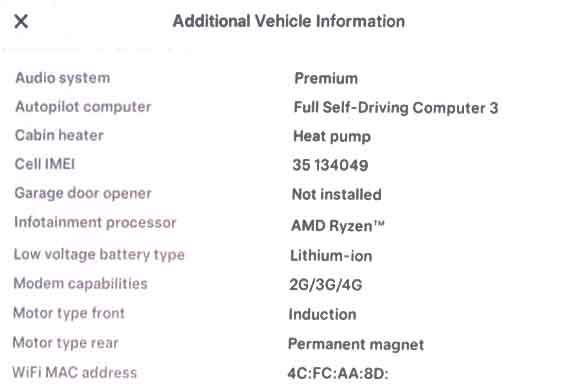
This is a car with FSD HW3 hardware Ryzen MCU, Lithium Ion low voltage battery. It also has a heat pump and the premium Audio. It was taken from a 2023 M3 Performance
-
Raven with MCU2, resistive heating, homelink and cold weather pack

This is taken in 2023. The car is a Raven model as it has the Adaptive suspension, but the infotainment processor is the Intel Atom so MCU2. The cabin heater is also Resistive so there is no heat pump.
We'd still love to see supercharging and whether it transfers somewhere explicitly stated, but at least the key features are also now spelt out.
-
Ryzen MCU, Heat pump, Lithium Ion LV battery
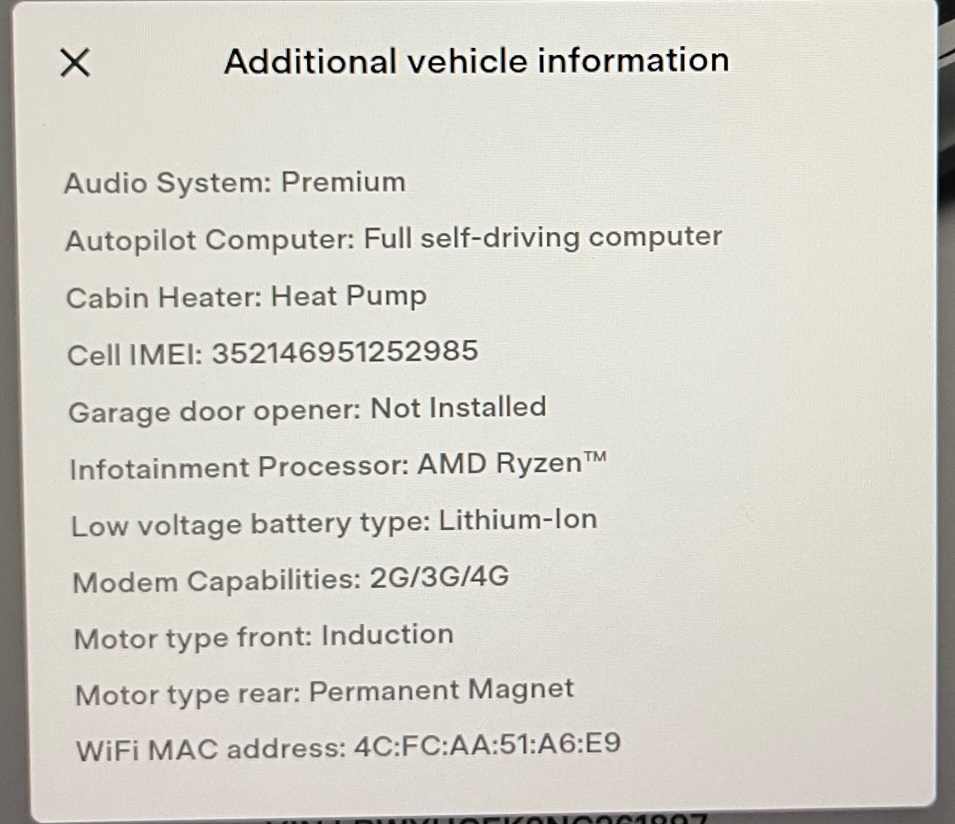
This is a later cars with the Ryzen MCU processor, heat pump is indicated, as is the Lithium Ion Low voltage battery which started to appear on M3 and MY at the beginning of 2022.
We'd still love to see supercharging and whether it transfers somewhere explicitly stated, but at least the key features are also now spelt out.
-
Autopilot 1 and MCU 1
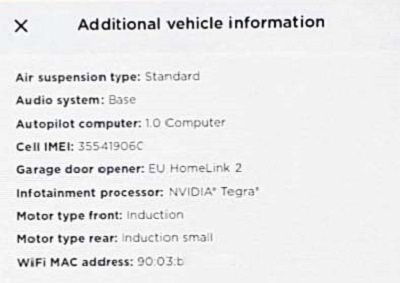
The earliest cars with Autopilot hardware will have an Autopilot "1.0 computer" which is the Mobileye system and will either have no autopilot or AP1 software activated. This hardware and software is at its limit and cannot be further upgraded by Tesla other than minor changes to performance. Only Model S and some very early Model X can have this combination.
The details also indicated the NVIDIA Infotainment system which means the car has MCU1. This has a known weakness and will has limitations on some of the features the later cars have. We cover the MCU1 issues with its eMMC memory elsewhere on the website.
Other key information that can be determined from this screen include the car having air suspension, the car has the basic audio, and the car has the HomeLink option. By its absence, the car does not have the cold weather (also known as sub-zero) pack.
-
Autopilot HW2 and MCU 1
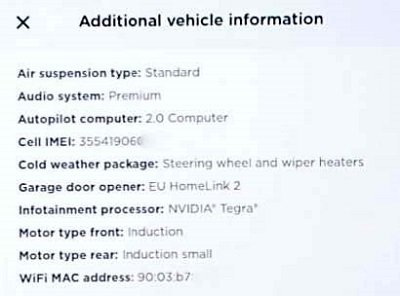
The first version of the Tesla autopilot hardware is known as HW2 (or "2.0 Computer" as displayed here. Cars with this hardware are fairly limited in some of the newer features such as summon and sentry mode. We provide a full list of the feature differences elsewhere.
The details also indicated the NVIDIA Infotainment system which means the car has MCU1. We cover the MCU1 issues with its eMMC memory elsewhere on the website.
Other key information that can be determined from this screen include the car having air suspension, the upgraded audio, the cold weather or subzero pack and the HomeLink option.
-
Autopilot HW2.5 and MCU 1
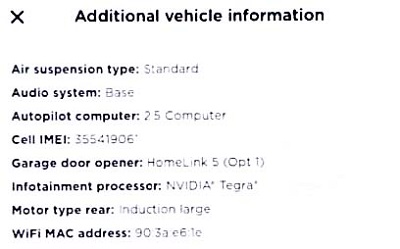
The second version of the Tesla autopilot hardware is known as HW2.5 (or "2.5 Computer" as displayed here. We provide a full list of the feature differences elsewhere.
The details also indicated the NVIDIA Infotainment system which means the car has MCU1. We cover the MCU1 issues with its eMMC memory elsewhere on the website.
Other key information that can be determined from this screen include the car having air suspension, the basic audio, and the HomeLink option. The Induction large rear motor says this car is a performance model if an MS or MX model.
-
Autopilot HW2.5 and MCU 2
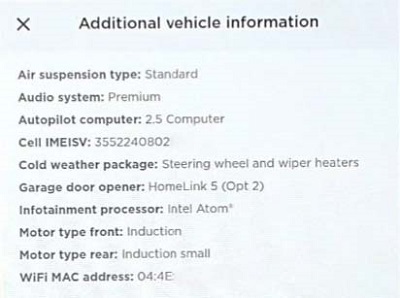
The second version of the Tesla autopilot hardware is known as HW2.5 (or "2.5 Computer" as displayed here. We provide a full list of the feature differences elsewhere.
The details also indicated the Intel Infotainment system which means the car has MCU2. This has many benefits over the earlier MCU1 system which we detail elsewhere.
Other key information that can be determined from this screen include the car having air suspension, the premium audio, the cold weather pack, and the HomeLink option.
-
Autopilot HW3 and MCU 2
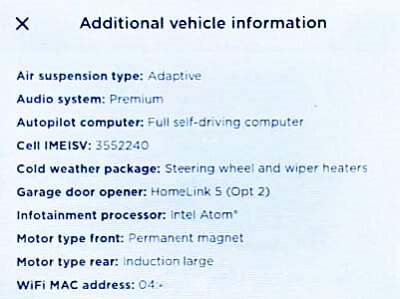
The latest version of the Tesla autopilot hardware and is also known as HW3 although Tesla refer to it as the Full self-driving computer. Note, this alone does not mean the car has the full self-driving software activated.
The details also indicated the Intel Infotainment system which means the car has MCU2. This has many benefits over the earlier MCU1 system which we detail elsewhere.
The details also refer to the air suspension as being adaptive. This implies the car is one of the Raven models with the latest suspension option on the MS and MX.
The Motor type front is referred to as "Permanent magnet" which implies this car also has the latest motor and supports one foot driving.
Other key information that can be determined from this screen include the car having the premium audio, the cold weather pack, and the HomeLink option. The large rear induction motor also means the car is a performance model if an MS or MX model.
-
Tow package
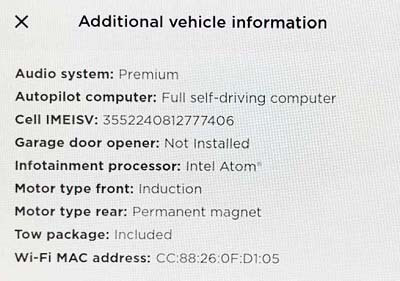
This car has the tow package as shown by the last but one item.
It also has the premium audio and full self-driving computer and MCU2 (the car is a Model 3).
-
MCU3 or Ryzen Infotainment processor
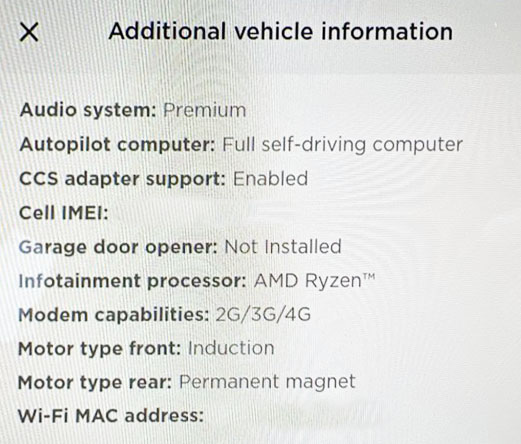
This car has the Ryzen MCU also known as MCU3.
It also has the premium audio, full self-driving computer and CCS support.
Other tips
There are a number of other things you can quickly determine from screenshots of the car:
Model S Panoramic sunroof from quick controls
The Model S used to have an option for a panoramic sunroof. Some dealers call the all glass roof a panoramic roof which isn't strictly correct and can cause confusion. From the Quick controls menu page you will see a top down view of the car and the panoramic roof controls will be obvious as shown in the first picture but not the second.
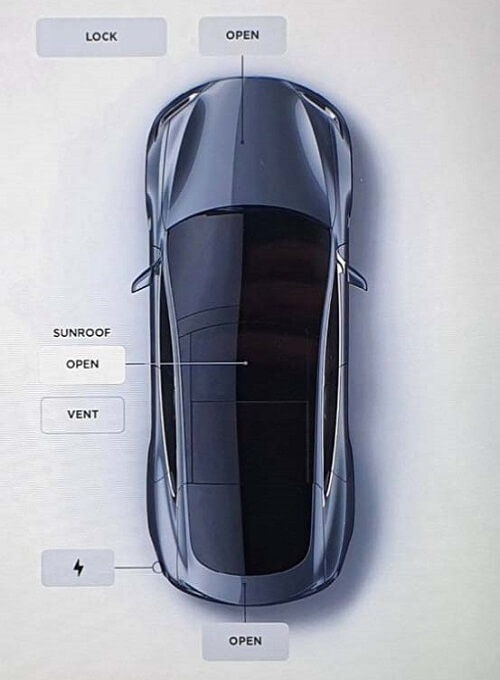
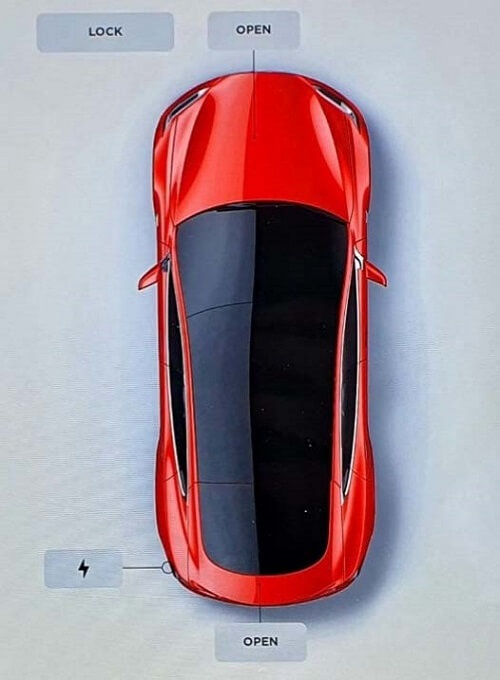
Free supercharging
This is one of the hardest features to determine but generally free supercharging is not transferable even if the car currently has it unless the car was ordered by Jan 2017 and delivered by April 2017, and even if it was first registered between those dates, it still may not have free supercharging as Tesla may have subsequently removed it. For more information on this topic see guide to supercharging to determine what option you have.
Charger speed
The Model S and Model X can have different on-board chargers with a different max AC charge rate. Early, pre facelift Model S could have (in Europe at least) a second on-board charger increasing the maximum charge speed from 11kw to 22kw should the charge point support it. The facelift Model S and the Model X came with a new on-board charger that was limited to 11kw with an option to increase it to 17kw. To determine which the car has, call up the charging screen by pressing the lightning bolt at the top of the screen, if the max current says 16A the car is limited to 11kw, if it says 24A it has 17kw charging capability and if it says 32A it has 22KW charging capability.